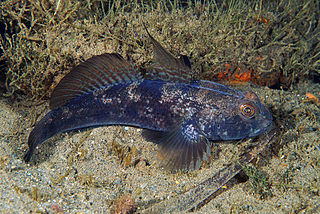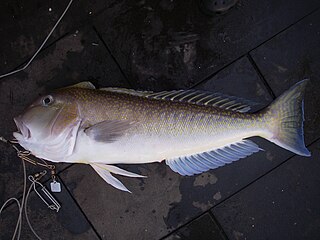
Gobiidae or gobies is a family of bony fish in the order Gobiiformes, one of the largest fish families comprising more than 2,000 species in more than 200 genera. Most of gobiid fish are relatively small, typically less than 10 cm (3.9 in) in length, and the family includes some of the smallest vertebrates in the world, such as Trimmatom nanus and Pandaka pygmaea, Trimmatom nanus are under 1 cm long when fully grown, then Pandaka pygmaea standard length are 9 mm (0.35 in), maximum known standard length are 11 mm (0.43 in). Some large gobies can reach over 30 cm (0.98 ft) in length, but that is exceptional. Generally, they are benthic or bottom-dwellers. Although few are important as food fish for humans, they are of great significance as prey species for other commercially important fish such as cod, haddock, sea bass and flatfish. Several gobiids are also of interest as aquarium fish, such as the dartfish of the genus Ptereleotris. Phylogenetic relationships of gobiids have been studied using molecular data.

Blenny is a common name for many types of fish, including several families of percomorph marine, brackish, and some freshwater fish sharing similar morphology and behaviour. Six families are considered "true blennies", grouped under the order Blenniiformes; its members are referred to as blenniiformids. About 151 genera and nearly 900 species have been described within the order. The order was formerly classified as a suborder of the Perciformes but the 5th Edition of Fishes of the World divided the Perciformes into a number of new orders and the Blenniiformes were placed in the percomorph clade Ovalentaria alongside the such taxa as Cichliformes, Mugiliformes and Gobiesociformes.

The tiger pistol shrimp belongs to the Alpheidae family, known commonly as snapping shrimp.

Ophichthidae is a family of fish in the order Anguilliformes, commonly known as the snake eels. The term "Ophichthidae" comes from Greek ophis ("serpent") and ichthys ("fish"). Snake eels are also burrowing eels. They are named for their physical appearance, as they have long, cylindrical, snake-like bodies. This family is found worldwide in tropical to warm temperate waters. They inhabit a wide range of habitats, from coastal shallows and even rivers, to depths below 800 m (2,600 ft). Most species are bottom dwellers, hiding in mud or sand to capture their prey of crustaceans and small fish, but some are pelagic.

The New Zealand sand diver is a species of sandburrower endemic to the waters around New Zealand where it can be found in tide pools and areas with sandy substrates down to a depth of 5 metres (16 ft). This species can grow to a length of 7 centimetres (2.8 in) TL. This species is the only known member of its genus.

The long-finned sand diver or tommyfish, is a species of sandburrower endemic to the coastal waters around the North Island of New Zealand to depths of about 6 metres (20 ft), on sandy or gravelly bottoms. It can reach a length of 7.2 centimetres (2.8 in) TL.
Limnichthys rendahli is a species of sandburrower endemic to the waters around New Zealand to depths of about 150 m, on sandy or gravelly bottoms. Its length is between 3 and 8 cm.

Trachiniformes is an order of percomorph bony fish, whose contents are traditionally placed in suborder Trachinoidei of Perciformes.

The Gobiiformes are an order of fish that includes the gobies and their relatives. The order, which was previously considered a suborder of Perciformes, is made up of about 2,211 species that are divided between seven families. Phylogenetic relationships of the Gobiiformes have been elucidated using molecular data. Gobiiforms are primarily small species that live in marine water, but roughly 10% of these species inhabit fresh water. This order is composed chiefly of benthic or burrowing species; like many other benthic fishes, most gobiiforms do not have a gas bladder or any other means of controlling their buoyancy in water, so they must spend most of their time on or near the bottom. Gobiiformes means "goby-like".

The great northern tilefish or golden tile, is the largest species in the family Malacanthidae (tilefishes). It grows to a length of between 38 and 44 inches. The great northern tilefish is a slow-growing and long-lived species that has four stages of life. After hatching from eggs, the larvae are found in plankton. As they grow into juveniles, the individuals seek shelter until finding or making their own burrows. As adults, the tilefish continue to expand their burrows in the sediment throughout their lives. The diet of the larvae is unknown, but presumed to consist of zooplankton; juveniles and adults feed upon various benthic invertebrates, crustaceans, and fish. After reaching sexual maturity between 5 and 7 years of age, females lay eggs throughout the mating season for the male to fertilize, with each female laying an average of 2.3 million eggs.
Apodocreedia vanderhorsti, the longfin burrower, is a species of sandburrower native to the Indian Ocean coast of southern Africa where it can be found from Delagoa Bay, Mozambique to Durban, South Africa. It occurs from the intertidal zone to a depth of approximately 16 metres (52 ft). This species grows to a length of 8 centimetres (3.1 in) TL. This species is the only known member of the genus Apodocreedia.

Limnichthys is a genus of sandburrowers native to the Indian and Pacific oceans.
Schizochirus insolens, the brokenfin sandburrower, is a species of sandburrower native to the coastal waters and bays of eastern Australia from Rockhampton, Queensland to Sydney. This species grows to a length of 5.3 centimetres (2.1 in) SL. This species is the only known member of its genus.

Limnichthys fasciatus, the barred sand burrower, is a species of sandburrower. It is noted for its highly developed eyes, with a structure similar to the eyes of a chameleon, which has led it to be described as marine chameleon. Its fully grown length measures between 20 millimetres (0.79 in) and 40 millimetres (1.6 in). The species is native to reefs in the Indo-Pacific. The fish preys on plankton prey by surprise attacking it from a hiding in loose sand, with only the eyes protruding from the sand.
Creedia alleni is a species of sandburrowers found in the Eastern Indian Ocean in Australia. This species reaches a length of 4 cm (1.6 in).
Creedia bilineata is a species of sandburrowers found in the Northwest Pacific Ocean around Japan. This species reaches a length of 3.2 cm (1.3 in).
Creedia haswelli, the slender sandburrower, is a species of marine ray-finned fish belonging to the family Creediidae, the sandburrowers. This species is found in Southern Australia. This species reaches a length of 7.5 cm (3.0 in).
Acropoma musorstom is a species of bioluminescent lanternbelly found in Vanuatu.









